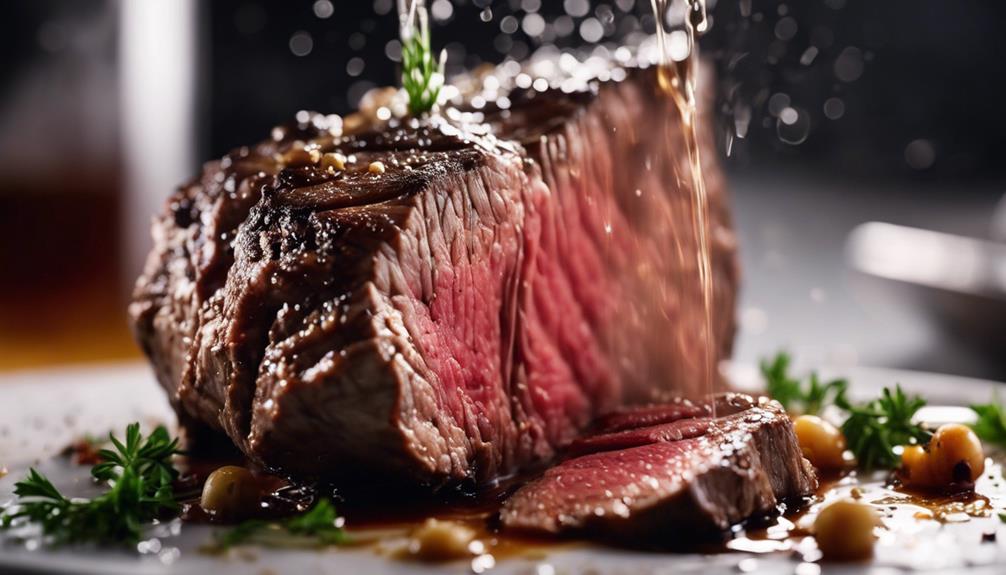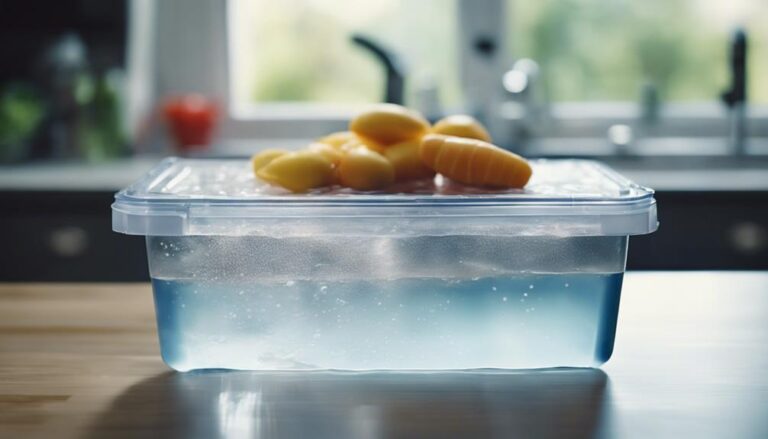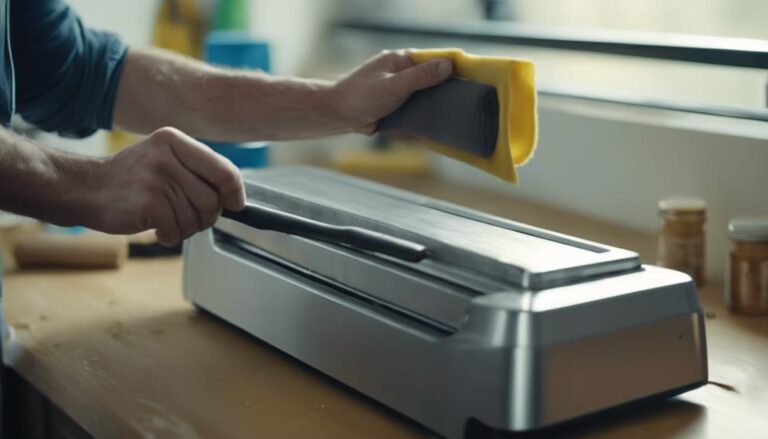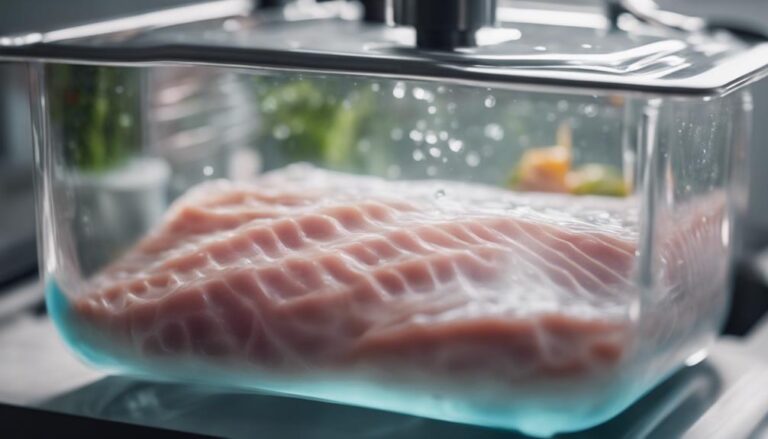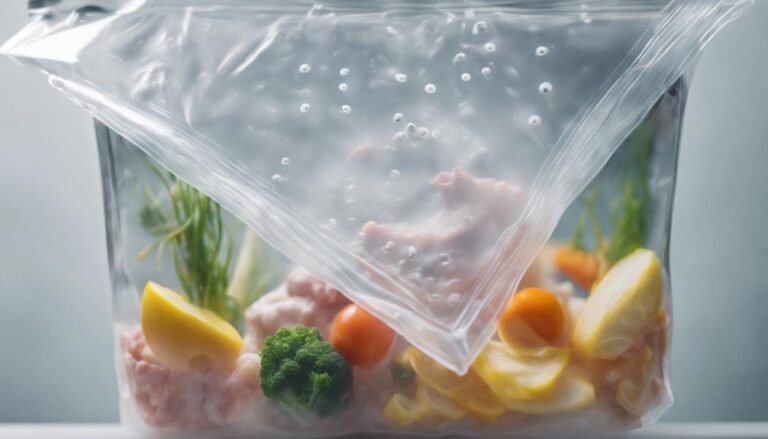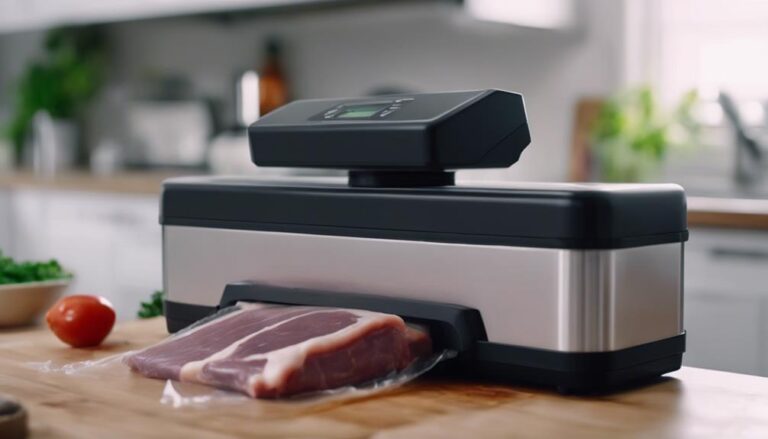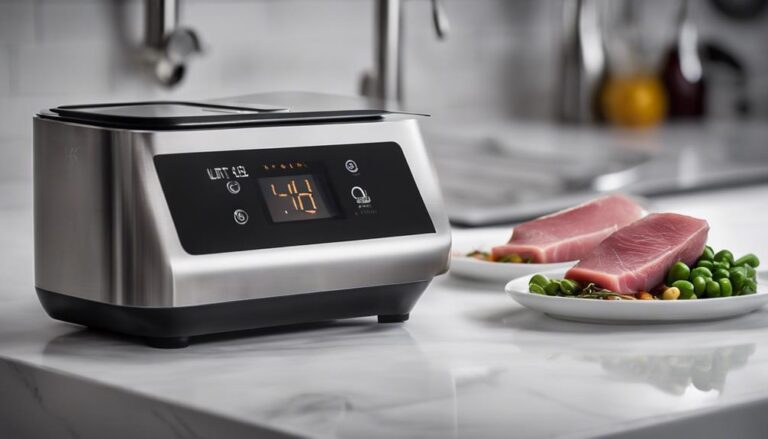Post-Cook Perfection: Finishing Techniques for Sous Vide Cooking
To achieve post-cook perfection in your sous vide dishes, focus on perfecting finishing techniques. Master searing in the oven, with a torch, or on a grill for elevated flavor and texture. Enhance your results by experimenting with different cuts and advanced searing methods. Elevate your sous vide cooking to new heights with these techniques.
What You Will Learn Here
- Oven searing enhances texture and flavor, especially for specific cuts.
- Utilize high heat for quick and even sear in the oven.
- Experiment with coatings or crusts to add depth to flavors.
- Broil for a quick sear, focusing on placement and ideal cuts.
- Torch searing offers precise browning and intense heat for perfect finishing.
Oven Searing Techniques
Have you ever wondered why oven searing may not be the most effective method for finishing sous vide-cooked foods?
When it comes to searing in the oven, achieving the desired texture can be a concern. While oven searing can be advantageous for drying out specific cuts like brisket or pork shoulder, it may not always deliver the same results as other finishing techniques.
One of the benefits of using the oven for searing is the ability to add coatings or crusts to the outside of the food, enhancing both flavor and texture. Additionally, the oven is particularly useful for searing irregularly shaped meats efficiently and for handling a large quantity of sous vide meat at once.
Although oven searing has its place in the domain of finishing techniques for sous vide cooking, contemplating the texture concerns and the necessity for enhanced flavor when deciding on the best method for achieving post-cook perfection is crucial.
Benefits of Oven Finishing
Oven finishing offers a convenient method for enhancing texture and flavor by allowing the addition of coatings or crusts to sous vide-cooked meats. The benefits of oven finishing go beyond just adding these delicious layers. It provides a way to dry out specific cuts like brisket or pork shoulder effectively after sous vide cooking, ensuring the perfect texture.
By utilizing high-heat in the oven, you can achieve a quick and even sear on the meat, marrying the precision of sous vide with traditional cooking methods. This method is particularly useful for searing irregularly shaped meats or when you need to sear a large quantity of sous vide meat efficiently. The oven's high temperatures play a significant role in creating that crisp exterior while keeping the inside perfectly cooked.
Next time you serve a meal prepared through sous vide cooking, consider the benefits of oven finishing to elevate the flavors and textures of your meats.
Achieving Crispy Textures
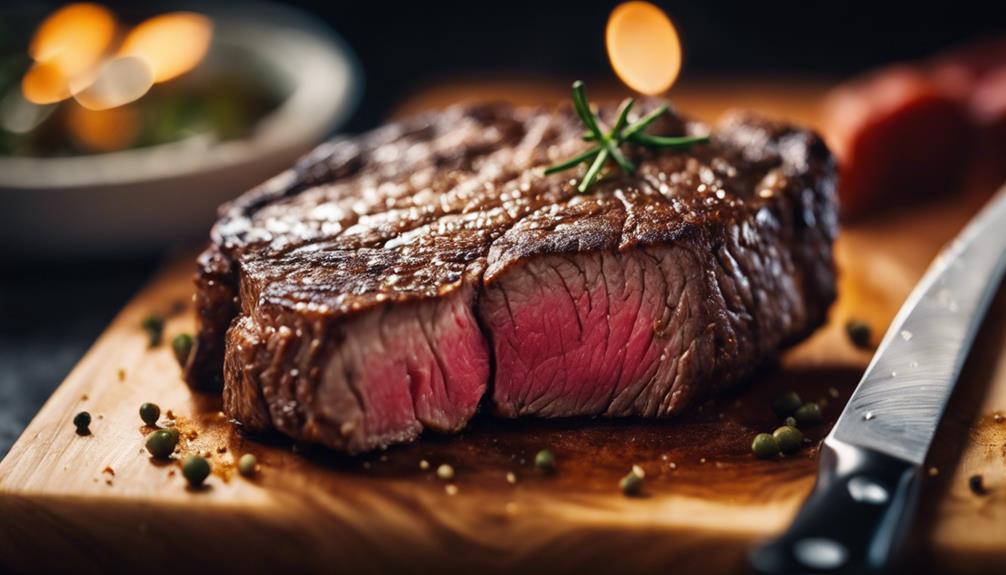
To achieve crispy textures when finishing sous vide meats, consider searing them in a hot pan with high smoke point oil to promote browning. This method helps create a delicious crust on the surface of the meat, enhancing both the flavor and texture.
If you prefer a more controlled approach, using a kitchen torch allows you to precisely char the exterior, achieving a crispy finish without overcooking the inside.
For a quick and even sear that elevates the texture, deep frying sous vide foods is a fantastic option.
Additionally, experimenting with finishing sous vide meats on a grill can add a smoky flavor while creating a crispy exterior.
To make sure an evenly seared surface, utilizing a Searzall attachment for torches can help you achieve that perfect crispy texture every time.
These finishing techniques provide a variety of options for achieving the desired level of crispiness in your sous vide dishes.
Tips for Searing in Oven
For achieving a different searing technique, consider utilizing your oven when finishing sous vide meats. Searing in the oven can be a game-changer, especially for cuts like brisket or pork shoulder that benefit from being dried out effectively. This searing method allows you to add coatings or crusts to the outside of your sous vide food, enhancing its texture and flavor profile.
By combining sous vide cooking with traditional techniques, the oven method offers versatility in preparation, making it ideal for searing irregularly shaped meats or when you need to sear a large quantity of sous vide meat efficiently.
To achieve a quick and consistent sear, set your oven at high temperatures and make sure to flip the meat for even searing. This technique not only helps in creating a beautiful crust on your meat but also locks in the juices, resulting in a mouthwatering and tender final product. So, next time you're looking to elevate your sous vide dishes, consider giving oven searing a try for that perfect finishing touch.
Enhancing Flavors Through Oven
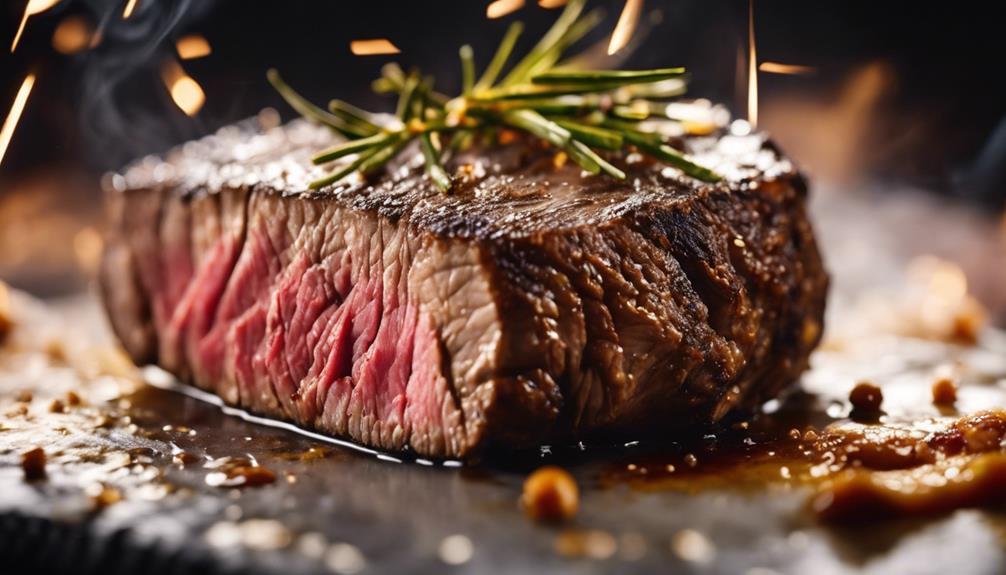
Consider enhancing the flavors of your sous vide dishes by utilizing the oven for a transformative finishing touch. Searing in the oven can't only add depth to the flavors but also contribute to enhanced texture, especially for cuts like brisket or pork shoulder.
To elevate your dishes further, experiment with adding coatings or crusts before searing in the oven for a delightful crunch or added flavor dimension. This method allows for a fusion of sous vide precision with the traditional cooking techniques that bring out rich, complex tastes.
Additionally, the oven is efficient in evenly searing irregularly shaped meats, ensuring a consistent finish across all parts. If you're serving a large quantity of sous vide meat, the oven method proves to be a time-saving and effective way to achieve that perfect sear while infusing your dishes with enticing flavors.
Oven Searing for Different Cuts
When oven searing different cuts after sous vide cooking,
you'll want to know:
- the best temperature for searing,
- the timing for ideal results, and
- the searing techniques for tenderness.
Best Temperature for Searing
Wondering how to achieve the perfect sear on different cuts of meat after sous vide cooking? When it comes to oven searing, the best temperature for achieving a deep crust on steaks and roasts is between 450-500°F. Thicker cuts like brisket or pork shoulder, however, benefit from lower temperatures around 300-350°F to prevent drying out. Searing in the oven offers even browning on irregularly shaped meats such as roasts or whole chickens. For a quick and efficient browning method, consider broiling in the oven by placing the food close to the heat source. This method guarantees rapid browning while keeping the interior moist. Oven searing is a practical choice for batch cooking, allowing you to efficiently sear a larger quantity of sous vide meats.
| Cut | Ideal Temperature Range (°F) |
|---|---|
| Steaks | 450-500 |
| Roasts | 450-500 |
| Brisket | 300-350 |
| Pork Shoulder | 300-350 |
Timing for Optimal Results
To achieve the best results when oven searing different cuts of meat after sous vide cooking, adjust the searing time based on the thickness and type of cut for desired doneness. Here's a guide to help you customize your searing process:
- Thick Cuts: Allow for longer searing times in the oven for cuts like ribeye or pork chops.
- Lean Cuts: Briefly sear lean cuts such as chicken breasts or fish fillets to prevent overcooking.
- Delicate Items: Opt for a quick broil in the oven for delicate items like scallops or shrimp to maintain tenderness.
- Thinner Cuts: For cuts like skirt steak or salmon steaks, a short sear in the oven can keep the interior juicy while achieving a caramelized crust.
Adjusting the distance from the broiler allows for customization based on thickness and desired doneness.
Searing Techniques for Tenderness
For achieving ideal tenderness in various cuts of meat post sous vide cooking, oven searing offers a versatile method that complements the sous vide precision with traditional cooking techniques.
When it comes to tenderizing cuts like brisket or pork shoulder, oven searing helps dry them out before serving, enhancing their texture. This technique allows you to add coatings or crusts to the exterior of your sous vide cooked meats, elevating both flavor and presentation.
Oven searing is particularly useful for searing irregularly shaped meats evenly and efficiently, ensuring a consistent finish. Additionally, this method is perfect for searing a large quantity of sous vide meat at once, making it a time-saving and practical choice for serving guests.
Advanced Oven Searing Methods
When looking to elevate your oven searing game for sous vide dishes, consider broiling for a quick sear that locks in juices, using a torch for a precise finish on smaller areas, and utilizing cast iron searing for a deep, flavorful crust.
These advanced oven searing methods offer unique ways to enhance the texture and taste of your sous vide creations, providing a perfect balance of tenderness and caramelization. Experiment with these techniques to take your sous vide finishing to the next level.
Broil for Quick Sear
For intense browning and flavorful crust creation, consider utilizing the high-heat broiling method to quickly sear your sous vide-cooked meats in the oven.
When broiling, follow these essential steps:
- Placement: Make sure the sous vide-cooked meat is placed on a rack under the broiler element for best searing.
- Efficiency: Broiling efficiently caramelizes the exterior while maintaining the meat's tenderness and juiciness inside.
- Ideal Cuts: Thicker cuts of meat benefit most from the rapid sear and color development broiling provides.
- Timing: Pay close attention to timing to prevent overcooking and achieve a perfect finish every time.
Mastering the art of broiling will elevate your dishes, impressing those you serve with beautifully seared and flavorful meats.
Torch for Precise Finish
Achieve precise browning and caramelization on your sous vide-cooked meats by utilizing a torch for a controlled and flavorful finish. Torch searing provides the assurance needed to guarantee even color development on the surface of your meats.
The intense heat from the torch caramelizes sugars and proteins, enhancing the flavor and texture of your dish. This method is particularly beneficial for intricate cuts or uneven surfaces where traditional searing techniques might fall short.
Recommended torch models such as the Bernzomatic TS8000 and Iwatani Torch deliver consistent and efficient performance for sous vide finishing, making them reliable choices for enhancing the presentation and taste of your culinary creations.
Cast Iron Searing
Consider utilizing a cast iron pan for your sous vide meats to achieve a consistent and flavorful crust through advanced oven searing methods.
- Cast iron searing provides even heat distribution, ensuring a perfect crust every time.
- Preheat the cast iron pan to achieve the necessary high temperature for effective searing.
- The weight and thickness of a cast iron pan aid in the Maillard reaction, enhancing flavor.
- Using a cast iron pan for searing after sous vide cooking results in a visually appealing caramelized exterior, while keeping the interior moist and tender.
Frequently Asked Questions
What to Do With Sous Vide After Cooking?
After sous vide cooking, enhance your dish with flavorful searing, tasty marinades, crispy browning, savory sauces, seasoned glazing, herb-infused treats, buttery toppings, zesty rubs, tangy reductions, and sweet glazes. Elevate your meal for a delightful dining experience.
How Do You Finish a Roast After Sous Vide?
To finish a roast after sous vide, you can sear it in a hot pan for a flavorful crust, grill it for barbecue notes, or use a meat torch for charred edges. Each method guarantees a juicy finish.
How Do You Finish Steak in the Oven After Sous Vide?
To finish steak in the oven after sous vide, start by oven searing on direct heat. Consider using a broiling method for extra browning. Rest the juicy steak before slicing to savor the perfect texture and flavor.
Can You Sous Vide and Finish Later?
Yes, you can sous vide and finish later. Rapidly chill in an ice bath after cooking for food safety. Store in the fridge and reheat using sous vide or other methods. Proper handling and storage are crucial for delicious, safe results.
Conclusion
Now that you've learned about oven searing techniques for finishing sous vide cooking, get ready to take your dishes to the next level.
By using the oven to achieve crispy textures, enhance flavors, and experiment with different cuts, you'll be able to elevate your culinary skills and impress your guests.
Don't be afraid to try out advanced oven searing methods to truly perfect your post-cook creations. Happy cooking!
